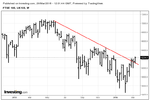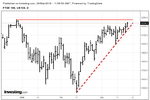barjon
Legendary member
- Messages
- 10,752
- Likes
- 1,863
Hi Kleft
Yes, thanks for that (sorry late reply but Cheltenham intervened).
I don't dispute anything you say which (in common with a few other things) introduces a note of "judgement" into SLA. That runs somewhat contrary to the "just follow the rules" stance that is oft quoted.
It doesn't surprise me that judgement must come into play and I wasn't intending venom in saying "expert trader" (although I was getting irritated by DB's writing off as beginner or fearful anyone not following his line of thought). I was trying to draw the distinction between "obey the rules" and the breaking of them by "the trader" when it happens to suit (always more obvious in hindsight than real time, of course, although I know DB tries to work from the left hand edge in his explanations).
Yes, thanks for that (sorry late reply but Cheltenham intervened).
I don't dispute anything you say which (in common with a few other things) introduces a note of "judgement" into SLA. That runs somewhat contrary to the "just follow the rules" stance that is oft quoted.
It doesn't surprise me that judgement must come into play and I wasn't intending venom in saying "expert trader" (although I was getting irritated by DB's writing off as beginner or fearful anyone not following his line of thought). I was trying to draw the distinction between "obey the rules" and the breaking of them by "the trader" when it happens to suit (always more obvious in hindsight than real time, of course, although I know DB tries to work from the left hand edge in his explanations).






